Meuterer
Game preparation
With /join can enter 3-4 players into the game. With /start the game begins. Alternatively, you can use the game management use.
The game
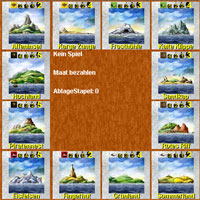
Actually, everything is quite peaceful on the merchant ship. With full loading spaces, the captain controls the next island to sell goods there. But the appearance is devastating, because the Meuterer has completely different meanings: together with the naval boy he tries to overthrow the captain to take the rudder in his hand. Can the captain rely on his faithful maat?
Players try to earn as many points as possible by selling their goods on the islands and muteries aboard each round.
The characters
Captain

The captain is always a starter. He determines the target of the round unless it is set off by mutiny. To him is the faithful maat.
The faithful Maat

The maat is at his side in the case of a mutiny. His presence alone counts a saber for the captain. The maat receives as a minimum wage a point, plus the points donated by the captain (see "PayMaat"); also in case there was no mutiny.
meuterine

The Meuterer tries to become a new captain through a mutiny. He is supported by the ship's boy. If the mutiny succeeds, he determines the new destination port and becomes captain in the next round. If the mutiny fails, the Meuterer will leave empty in this round.
Ship's boy

The ship's boy supports the meuter. In the case of a successful mutiny, the naval boy receives two win points as a reward. If there is no mutiny, or if it fails, it goes out empty.
Dealers

The dealer has advantages when selling goods: there is balance in most goods of an island, the dealer still gets the highest price.
master

The loader is valuable for the next round: it gets three more cards to choose when filling up the hand cards. But he can only keep five.
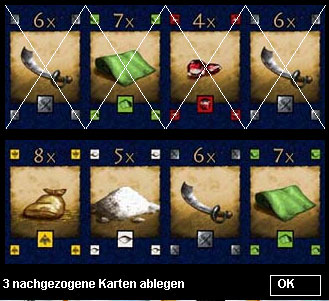
The cards that have been smeared show the handcards of the loader. From the rest, he has to drop the number of cards that he has five again. To do this, he clicks on the maps he they are wishes and confirmed with "OK".
Game sequence

In the middle of the field there is the game display, which can be found as follows:
- Current round
- current player
- Current action
- available maat points
- Number of cards of the draw-off stack, as well as the top card of the storage stack
Pay for Maat

A player is captain. At the beginning of each round, he determines how many win points he additionally donates to the Maat in case of successful support. These points will be deducted from the master's won island points.
Offer goods

In each round, players can try 1-2 islands to sell the native goods. The active islands have a brown frame instead of the grey frame.
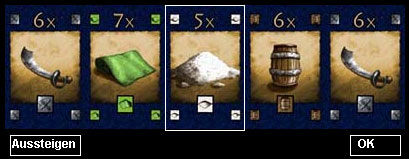
If you’re in the row, you’ll get a selection window with your handcards, select one you want to play and confirm the selection with “OK”.
If you want to get out, choose the "Get out" button (no card may be selected!)
Select character
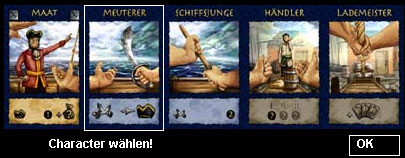
If you choose "off", the selection window for the characters appears (see above). Here you select a role in analogy and confirm with "OK".
Set a target

Primarily, the captain determines the destination for the next round. As soon as it has gone out, the number of his remaining hand cards determines the destination of the trip. The corresponding island is marked with the brown master sign. In the picture the captain had left a hand map, i.e. the ship would move around an island from ice rocks to Sandkap. Attention: on the target island can only be next Be sold round!
If the meuter is in the game, the expected target is marked with the blue meuter sign, also depending on the number of hands cards of the meuter.
In the selection of the target, the number of remaining hand cards applies in principle before play out additional sabers!
Meuts
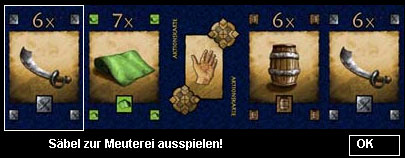
If the Meuterer was chosen, then any player involved in the Meuterei can now reihum - starting with the captain - still play saber from the hand to influence the outcome of the Meuterei.
The sabers which have already been designed in the product phase are added to those which are still designed. The following shall apply:
- the sabers of the ship's boy are part of the meuter
- the sabers of the maat count to the captain
If Meuterer and Schiffjunge together have more or equal numbers of sabers like the captain and the maat (the maat itself also counts as 1 saber!), the Meuterei and the Meuterer becomes new captain. The ship goes to the island, which was determined by the Meuterer due to its remaining hand maps. The Meuterer receives the number of points of victory on this island (top the right on the island map).
The navy boy gets two points, captain and maat go empty.
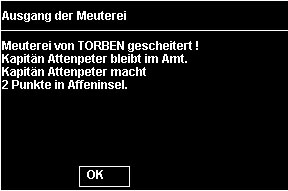
If the mutiny has failed, the ship will go to the island which was determined by the captain on the basis of his remaining hand cards. The captain receives the number of points of victory on this island (top the right of the island map) - minus the maat points donated.
Meuterer and shipboy go empty.
If there is no mutiny, the captain and the maat will still receive their points.
Selling goods

In most islands one can only sell exactly one raw material type (here in ice rocks, for example, only rubies). On the two islands with the "?" you can sell all kinds. On an island as many goods as possible a Variety will be sold. Basically, only players can sell goods that have the majority of goods on an island. The sale brings the following points of victory:
- if one has the majority alone, one gets the full score (here six)
- have two players the majority, both get the middle score (here 4)
- have three players the majority, get all three the lowest score (here 3)
If all four players have equal numbers of goods on an island, all go empty. If a player has chosen the dealer, he will always get the highest score at the same time.
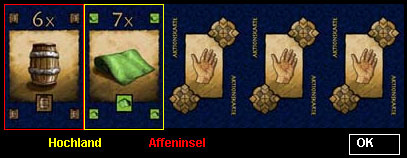
The goods are sold reihum, beginning with the captain. You get the sales window with its designed goods and choose here what goods you want to sell on which island.
Please note the colors: click on a merchandise once, get a yellow frame, click twice a red one, and the frame is removed again at a further click. The frame colour is analogous to the color of the island name.
In the picture you will mark the raw materials you want to sell in "highland" with a yellow frame, the raw materials for monkey island need a red frame. Here you also confirm the selection with "OK"
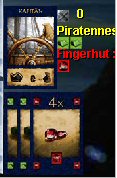
Each player will display the goods he sells on which island; two cloths are sold here in "Piratennest" and a ruby in "Fingerhut".
The sale of goods is an important tactical means: for example, it is possible to split its sales. For example, if there are five cereals, one can sell three of them on island A (Island) and two of them on island B (Island). Assuming, of course, you hold the majority.
The number of products varies according to variety. The frequency of their occurrence is indicated on each commodity card above.
Playing
The game ends at 3/4 players after 9/8 rounds.
Options
dm
If all four players sell the same number of goods, the dealer is also empty.

